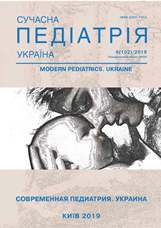Clinical and pathophysiological characteristics and significance of newborn cytopenia (neutropenia, leukopenia and lymphopenia)
Keywords:
newborn cytopenia, lymphopenia, neutropenia, combined immunodeficiencyAbstract
Cytopenias are common laboratory findings in the neonatal period and have different reasons and characteristics. They occur as benign transitory conditions and also as potentially dangerous «masks» of immunodeficiency and infectious diseases.Objective: to study frequency and causal factors of neutro-, lympho- and leukopenias in newborns and estimate their influence at quality of life and infectious morbidity rate.
Materials and methods. Medical records of 738 children, treated in newborn pathology department and intensive care department, were examined with absolute and relative count of neutrophils and lymphocytes. The thorough documental analysis of patients with cytopenias was provided and catamnesis of the follow-up infectious morbidity was took.
Results and conclusions. Neutropenia is a dominant type of cytopenias in infants (72.88%), it has benign transitory character in almost all cases and doesn't require any special correction; the most frequently type of comorbidity is combination of cytopenia and different infectious diseases (52.7%). The probably factors of newborn neutro- and lymphopenia development were established. There aren't correlation between follow-up infectious morbidity rate and cytopenia degree (r=0,016 for lymphopenias and r=0,0015 for neutropenias); the importance of clinical blood count (especially absolute neutrophils and lymphocytes count ) for early diagnosis of cytopenic conditions was also determined; the register of children with lymphopenia was created with a goal of further immunological examination and diagnosis of immunodeficiency disorders, especially severe combined immunodeficiency.
References
Al-Gwaitz LA. (2007). The diagnostic value of absolute neutrophil count, band count and morphologic changes of neutrophils in predicting bacterial infections. Medical Principles and Practice. 16(5): 344–7. https://doi.org/10.1159/000104806; PMid:17709921
Boxer L. (2002, Apr). Neutropenia: causes and consequences. Seminars in Hematology. 39(2): 75–81. https://doi.org/10.1053/shem.2002.31911; PMid:11957188
Boyarchuk O, Volokha A, Harian T. (2018). Primary immunodeficiencies: regional, national and global challenges. Visnyk naukovyh doslidzhen. 3: 142–145. https://doi.org/10.11603/2415-8798.2018.3.9270
Boyarchuk O, Lewandowicz-Uszynska A, Kinash M, Haliyash N et al. (2018). Physicians' awareness concerning primary immunodeficiencies in the Ternopil Region of Ukraine. Pediatira Polska. 93(3): 221–228.
Celkan T, Koç BŞ. (2015). Approach to the patient with neutropenia in childhood. Turkish Archives of Pediatrics. 50(3): 136–44. https://doi.org/10.5152/TurkPediatriArs.2015.2295; PMid:26568688 PMCid:PMC4629920
Del Vecchio A, Christensen RD (2012). Neonatal neutropenia: what diagnostic evaluation is needed and when is treatment recommended? Early Human Development. 88; 2: 19–24. https://doi.org/10.1016/S0378-3782(12)70007-5
Esbenshade AJ, Ho RH. (2011). Dapsone-induced methemoglobinemia: a dose-related occurrence? Cancer. 117(15): 3485–92. https://doi.org/10.1002/cncr.25904; PMid:21246536 PMCid:PMC3138875
Kisliak NS, Mamedova EA. (1991, Oct). Alloimmune neutropenia in newborns. Gematology and Transfuziology. 36(10): 32–5.
Maheshvari A. (2014) Neutropenia in the newborn. Current Opinion in Hematology.21(1): 43–9. https://doi.org/10.1097/MOH.0000000000000010; PMid:24322487 PMCid:PMC3904675
Puck JM. (2011). Neonatal screening for severe combined immunodeficiency. Current opinion in Pediatrics.23(6): 667–73. https://doi.org/10.1097/MOP.0b013e32834cb9b0; PMid:22001765 PMCid:PMC3299571
Shereen S El;Sayed. (2013). Neonatal screening for absolute lymphopenia. Egyptian Journal of Pediatric Allergy and Immunology. 11(2): 75–81.
Skokowa J, Germeshausen M, Zeidler C, Welte K. (2007). Severe congenital neutropenia: inheritance and pathophysiology. Current Opinion in Hematology.14: 22–28. https://doi.org/10.1097/00062752-200701000-00006; PMid:17133096
Walker H. (1990). Clinical Methods: The History, Physical, and Laboratory Examinations. 3rd edition. Boston: Butterworths-Chapter: 153.
Young B, Lye D. (2014). The absolute lymphocyte count accurately estimates CD4 counts in HIV-infected adults with virologic suppression and immune reconstitution. Journal of the International AIDS Society. 17;4(3): 19680. https://doi.org/10.7448/IAS.17.4.19680; PMid:25397430 PMCid:PMC4225342
Downloads
Issue
Section
License
The policy of the Journal “MODERN PEDIATRICS. UKRAINE” is compatible with the vast majority of funders' of open access and self-archiving policies. The journal provides immediate open access route being convinced that everyone – not only scientists - can benefit from research results, and publishes articles exclusively under open access distribution, with a Creative Commons Attribution-Noncommercial 4.0 international license (СС BY-NC).
Authors transfer the copyright to the Journal “MODERN PEDIATRICS. UKRAINE” when the manuscript is accepted for publication. Authors declare that this manuscript has not been published nor is under simultaneous consideration for publication elsewhere. After publication, the articles become freely available on-line to the public.
Readers have the right to use, distribute, and reproduce articles in any medium, provided the articles and the journal are properly cited.
The use of published materials for commercial purposes is strongly prohibited.

